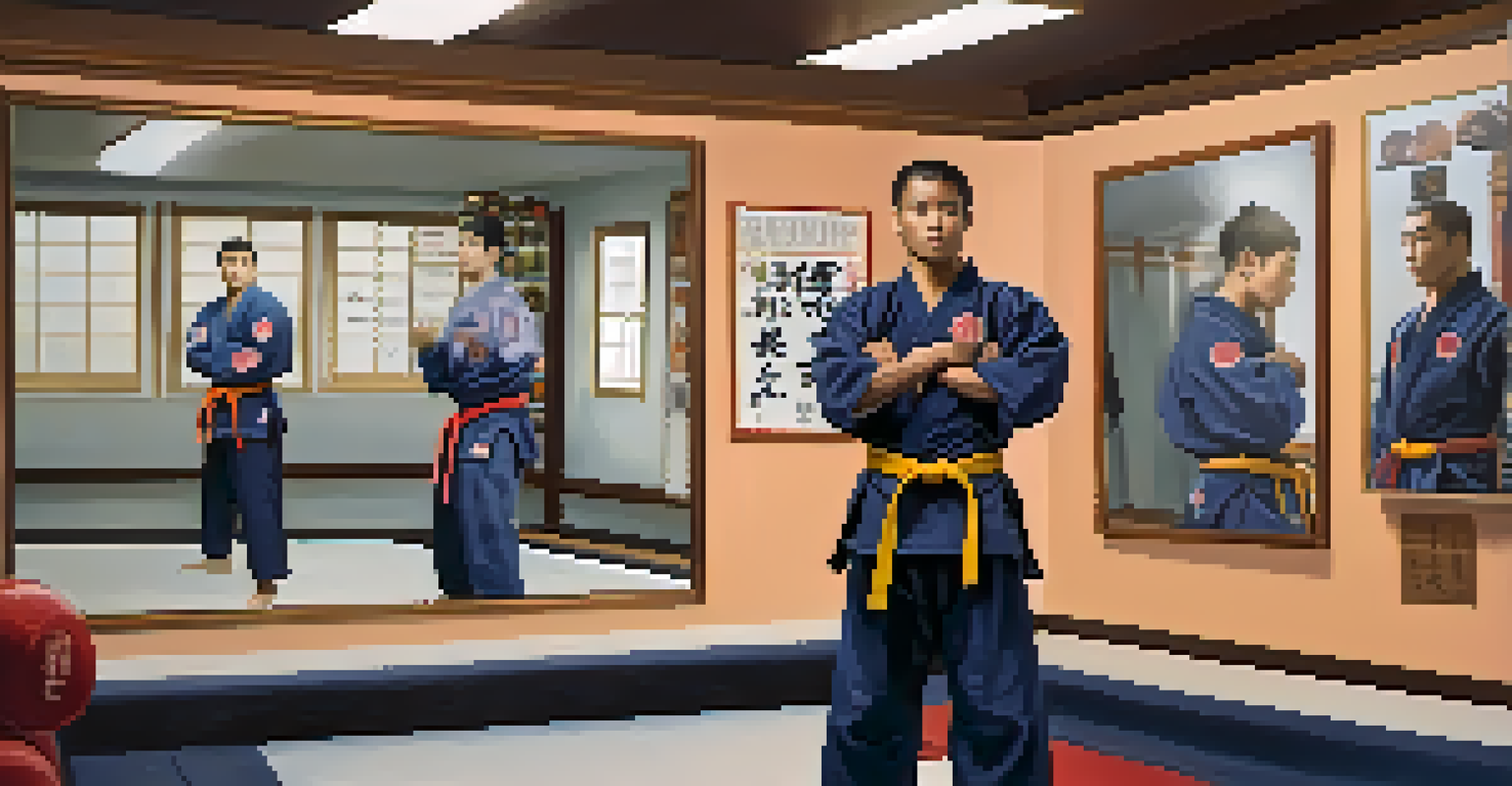Using Visualization Techniques for Mindful Martial Arts Practice

Understanding Visualization in Martial Arts Practice
Visualization is a powerful tool that can enhance your martial arts practice. It involves creating mental images to improve performance, focus, and mindfulness. By imagining movements and techniques, practitioners can prepare both mentally and physically for their training or competition.
The mind is everything. What you think you become.
This technique is not just about daydreaming; it’s about engaging your mind in a focused and intentional way. For instance, a martial artist might visualize executing a perfect roundhouse kick, imagining every detail from their stance to the impact of their foot. This mental rehearsal can lead to improved muscle memory and execution.
Moreover, visualization can help alleviate anxiety and boost confidence. When you repeatedly visualize success in your practice, it primes your brain to recognize those scenarios as achievable, making you more resilient in real-time situations.
The Science Behind Visualization Techniques
Research in psychology shows that visualization can activate similar brain pathways as actual physical practice. When you visualize an action, your brain sends signals to the muscles involved, which can enhance performance. This phenomenon explains why athletes, including martial artists, use visualization as a training tool.

Studies have demonstrated that regular visualization can lead to measurable improvements in skill execution. For example, one study found that participants who used visualization alongside physical practice showed greater gains in strength and technique than those who practiced only physically.
Visualization Enhances Performance
Mental imagery can prepare martial artists physically and mentally, leading to improved execution of techniques.
Understanding this scientific backing can empower martial artists to integrate visualization into their training regimen. It highlights that the mind-body connection is a crucial aspect of any physical discipline, including martial arts.
Incorporating Visualization into Your Training Routine
To start using visualization, set aside a few quiet moments before or after your martial arts practice. Find a comfortable position, close your eyes, and take deep breaths to center yourself. Then, begin to visualize your training sessions or upcoming competitions in vivid detail.
Visualization is daydreaming with a purpose.
Think about the specific techniques you want to focus on, the surroundings, and even the feelings associated with each movement. For instance, if you’re preparing for a sparring match, imagine yourself entering the dojo, feeling confident and calm as you execute your techniques flawlessly against your opponent.
Consistency is key here. Just as you would practice your kicks or punches regularly, make visualization a part of your routine. Over time, this practice can help you become more mindful and present, both on and off the mat.
Overcoming Challenges with Visualization Techniques
While visualization can be incredibly beneficial, it may come with its own set of challenges. Some practitioners find it difficult to focus or create clear mental images. This is completely normal, especially at the beginning, and can be improved with practice.
To overcome these challenges, start with simple techniques. Instead of trying to visualize an entire sparring session, focus on one specific move or technique. As you grow more comfortable, gradually expand the scope of your visualization practice.
Mindfulness Through Visualization
Engaging in visualization can create a calming mental space, helping to reduce stress and enhance focus during training.
Remember, the goal is not perfection but rather to cultivate awareness and enhance your practice. Be patient with yourself, and celebrate small victories as you develop your visualization skills.
Using Visualization for Mindfulness and Stress Relief
Mindfulness is essential in martial arts and can be amplified through visualization. By visualizing peaceful scenarios or the flow of energy within your body, you can create a calming mental environment that enhances focus and relaxation. This practice can help reduce stress levels, making your training more enjoyable.
For example, you might visualize yourself in a serene setting, like a quiet forest or beside a calm lake, while practicing your breathing techniques. This not only helps in grounding you but also enhances your overall martial arts experience as you connect with your inner self.
Incorporating visualization for mindfulness can also lead to improved emotional regulation. By frequently engaging in these calming visualizations, you can learn to better manage stressors both in and out of the dojo.
Visualizing Success: Building Confidence in Martial Arts
Visualization is a fantastic way to build confidence in your martial arts abilities. By imagining yourself succeeding in various scenarios, you're essentially programming your mind for success. This mental preparation can have a profound effect on your actual performance during training and competitions.
For instance, if you visualize yourself successfully executing a complex technique or winning a match, you begin to internalize those images. When faced with the real situation, your brain recognizes it as familiar, reducing anxiety and boosting your confidence.
Building Confidence with Visualization
Imagining success in various scenarios programs the mind for achievement, boosting confidence in real-life situations.
This practice not only enhances your technical skills but also fosters a positive mindset. By regularly visualizing success, you're creating a mental blueprint that encourages you to strive for your best in every training session.
The Long-Term Benefits of Visualization in Martial Arts
The effects of visualization extend beyond immediate performance improvements. Over time, this technique can lead to a deeper understanding of your martial arts practice and a stronger connection to your body and mind. As you become more adept at visualizing, you may find yourself more aware of your movements and intentions.
Additionally, consistent use of visualization can help in injury recovery. By visualizing your movements during rehabilitation, you can maintain a sense of practice and connection to your techniques, which aids in mental and physical healing.

Ultimately, the long-term benefits of incorporating visualization into your martial arts practice can transform not just your skills but your entire approach to training. It encourages a holistic view of martial arts that encompasses mind, body, and spirit.